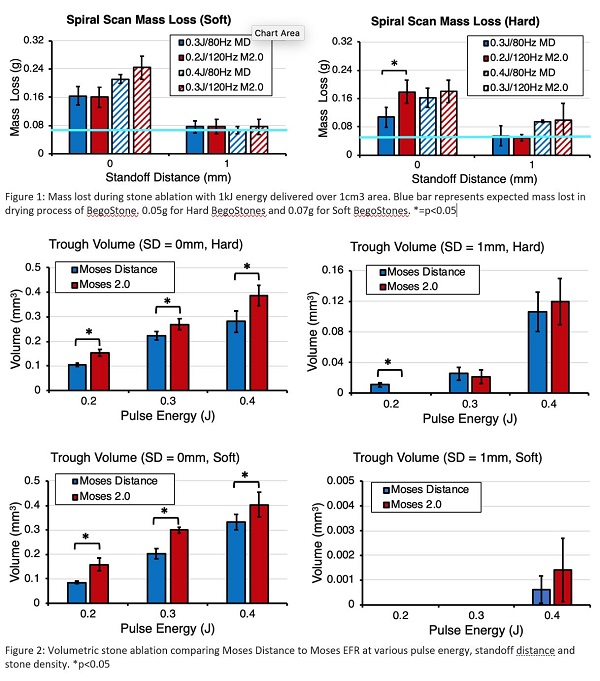Back
Poster, Podium & Video Sessions
Moderated Poster
MP32: Surgical Technology & Simulation: Instrumentation & Technology I
MP32-04: Another One Bites the Dust: Evaluating the Efficacy of the Extended Frequency Range of the Moses 2.0 Laser System in an in vitro Stone Dusting Model
Saturday, May 14, 2022
2:45 PM – 4:00 PM
Location: Room 225
Patrick Whelan, Christopher Kim, Christian Tabib*, Pei Zhong, Glenn Preminger, Michael Lipkin, Durham, NC
- CT
Christian H. Tabib, MD
Duke University
Poster Presenter(s)
Introduction: Moses laser technology utilizes pulse modulation to enhance energy delivery, minimize retropulsion, and improve stone dusting compared with the standard short pulse. The Moses 2.0 laser system provides Extended Frequency Range (EFR) technology allowing for higher frequency pulse settings up to 120Hz. Our aim is to compare the dusting efficiency of Moses EFR technology and non-EFR using Moses Distance (MD) pulse mode in an automated in vitro model.
Methods: All tests were conducted using a Moses 2.0 laser system on hard and soft Begostone phantoms, mimicking calcium oxalate monohydrate and uric acid stones, respectively. The settings for MD and EFR were compared amongst groups using similar power (MD: 0.3J/80Hz vs EFR: 0.2J/120Hz; MD: 0.4J/80Hz vs EFR: 0.3J/120Hz). The laser fiber was scanned in a spiral to deliver 1kJ of energy over a 1 cm2 area using an automated 3D positioning system across a submerged Begostone surface at standoff distances (SD) of 0 and 1mm. Stone ablation volume was measured. The laser was then scanned across a Begostone surface without contacting the same location twice, creating a trough. Equivalent energies were used for MD and EFR (0.2, 0.3, and 0.4J). Using the frequency setting, the laser was scanned at a rate equivalent to allow for 50 pulses fired per mm. Ablation volumes of 1 mm trough segments were quantified.
Results: In spiral testing, EFR showed equivalent mass loss to MD and was significantly superior when comparing MD: 0.3J/80Hz vs EFR: 0.2J/120Hz at SD 0 mm (p < 0.05). EFR had superior trough ablation volume to MD across all pulse energies at SD 0mm (p < 0.05). These differences increased when using lower energy settings. Ablation volume increased with higher energy for both MD and EFR. At SD 1mm, MD was only significantly better using 0.2J on hard stones. However, 0.4J was needed to show ablation using either MD or EFR at 1mm.
Conclusions: EFR provided by Moses 2.0 technology offers superior trough ablation volumes when using similar energy settings. However, spiral scan testing only showed improved efficiency at 0mm. In order to improve stone ablation and dusting, the laser should be scanned across the stone surface at a faster rate when using EFR settings.
Source of Funding: None

Methods: All tests were conducted using a Moses 2.0 laser system on hard and soft Begostone phantoms, mimicking calcium oxalate monohydrate and uric acid stones, respectively. The settings for MD and EFR were compared amongst groups using similar power (MD: 0.3J/80Hz vs EFR: 0.2J/120Hz; MD: 0.4J/80Hz vs EFR: 0.3J/120Hz). The laser fiber was scanned in a spiral to deliver 1kJ of energy over a 1 cm2 area using an automated 3D positioning system across a submerged Begostone surface at standoff distances (SD) of 0 and 1mm. Stone ablation volume was measured. The laser was then scanned across a Begostone surface without contacting the same location twice, creating a trough. Equivalent energies were used for MD and EFR (0.2, 0.3, and 0.4J). Using the frequency setting, the laser was scanned at a rate equivalent to allow for 50 pulses fired per mm. Ablation volumes of 1 mm trough segments were quantified.
Results: In spiral testing, EFR showed equivalent mass loss to MD and was significantly superior when comparing MD: 0.3J/80Hz vs EFR: 0.2J/120Hz at SD 0 mm (p < 0.05). EFR had superior trough ablation volume to MD across all pulse energies at SD 0mm (p < 0.05). These differences increased when using lower energy settings. Ablation volume increased with higher energy for both MD and EFR. At SD 1mm, MD was only significantly better using 0.2J on hard stones. However, 0.4J was needed to show ablation using either MD or EFR at 1mm.
Conclusions: EFR provided by Moses 2.0 technology offers superior trough ablation volumes when using similar energy settings. However, spiral scan testing only showed improved efficiency at 0mm. In order to improve stone ablation and dusting, the laser should be scanned across the stone surface at a faster rate when using EFR settings.
Source of Funding: None

.jpg)
.jpg)